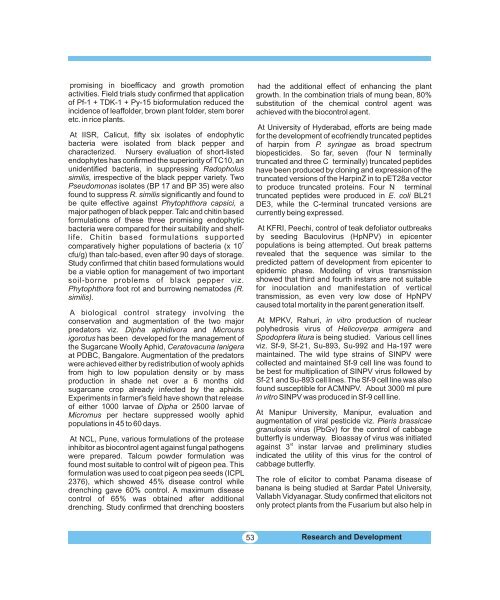ANNUAL REPORT - Department of Biotechnology
ANNUAL REPORT - Department of Biotechnology
ANNUAL REPORT - Department of Biotechnology
Create successful ePaper yourself
Turn your PDF publications into a flip-book with our unique Google optimized e-Paper software.
promising in bioefficacy and growth promotion<br />
activities. Field trials study confirmed that application<br />
<strong>of</strong> Pf-1 + TDK-1 + Py-15 bi<strong>of</strong>ormulation reduced the<br />
incidence <strong>of</strong> leaffolder, brown plant folder, stem borer<br />
etc. in rice plants.<br />
At IISR, Calicut, fifty six isolates <strong>of</strong> endophytic<br />
bacteria were isolated from black pepper and<br />
characterized. Nursery evaluation <strong>of</strong> short-listed<br />
endophytes has confirmed the superiority <strong>of</strong> TC10, an<br />
unidentified bacteria, in suppressing Radopholus<br />
similis, irrespective <strong>of</strong> the black pepper variety. Two<br />
Pseudomonas isolates (BP 17 and BP 35) were also<br />
found to suppress R. similis significantly and found to<br />
be quite effective against Phytophthora capsici, a<br />
major pathogen <strong>of</strong> black pepper. Talc and chitin based<br />
formulations <strong>of</strong> these three promising endophytic<br />
bacteria were compared for their suitability and shelflife.<br />
Chitin based formulations supported<br />
7<br />
comparatively higher populations <strong>of</strong> bacteria (x 10<br />
cfu/g) than talc-based, even after 90 days <strong>of</strong> storage.<br />
Study confirmed that chitin based formulations would<br />
be a viable option for management <strong>of</strong> two important<br />
soil-borne problems <strong>of</strong> black pepper viz.<br />
Phytophthora foot rot and burrowing nematodes (R.<br />
similis).<br />
A biological control strategy involving the<br />
conservation and augmentation <strong>of</strong> the two major<br />
predators viz. Dipha aphidivora and Microuns<br />
igorotus has been developed for the management <strong>of</strong><br />
the Sugarcane Woolly Aphid, Ceratovacuna lanigera<br />
at PDBC, Bangalore. Augmentation <strong>of</strong> the predators<br />
were achieved either by redistribution <strong>of</strong> wooly aphids<br />
from high to low population density or by mass<br />
production in shade net over a 6 months old<br />
sugarcane crop already infected by the aphids.<br />
Experiments in farmer's field have shown that release<br />
<strong>of</strong> either 1000 larvae <strong>of</strong> Dipha or 2500 larvae <strong>of</strong><br />
Micromus per hectare suppressed woolly aphid<br />
populations in 45 to 60 days.<br />
At NCL, Pune, various formulations <strong>of</strong> the protease<br />
inhibitor as biocontrol agent against fungal pathogens<br />
were prepared. Talcum powder formulation was<br />
found most suitable to control wilt <strong>of</strong> pigeon pea. This<br />
formulation was used to coat pigeon pea seeds (ICPL<br />
2376), which showed 45% disease control while<br />
drenching gave 60% control. A maximum disease<br />
control <strong>of</strong> 65% was obtained after additional<br />
drenching. Study confirmed that drenching boosters<br />
had the additional effect <strong>of</strong> enhancing the plant<br />
growth. In the combination trials <strong>of</strong> mung bean, 80%<br />
substitution <strong>of</strong> the chemical control agent was<br />
achieved with the biocontrol agent.<br />
At University <strong>of</strong> Hyderabad, efforts are being made<br />
for the development <strong>of</strong> ec<strong>of</strong>riendly truncated peptides<br />
<strong>of</strong> harpin from P. syringae as broad spectrum<br />
biopesticides. So far, seven (four N terminally<br />
truncated and three C terminally) truncated peptides<br />
have been produced by cloning and expression <strong>of</strong> the<br />
truncated versions <strong>of</strong> the HarpinZ in to pET28a vector<br />
to produce truncated proteins. Four N terminal<br />
truncated peptides were produced in E. coli BL21<br />
DE3, while the C-terminal truncated versions are<br />
currently being expressed.<br />
At KFRI, Peechi, control <strong>of</strong> teak defoliator outbreaks<br />
by seeding Baculovirus (HpNPV) in epicenter<br />
populations is being attempted. Out break patterns<br />
revealed that the sequence was similar to the<br />
predicted pattern <strong>of</strong> development from epicenter to<br />
epidemic phase. Modeling <strong>of</strong> virus transmission<br />
showed that third and fourth instars are not suitable<br />
for inoculation and manifestation <strong>of</strong> vertical<br />
transmission, as even very low dose <strong>of</strong> HpNPV<br />
caused total mortality in the parent generation itself.<br />
At MPKV, Rahuri, in vitro production <strong>of</strong> nuclear<br />
polyhedrosis virus <strong>of</strong> Helicoverpa armigera and<br />
Spodoptera litura is being studied. Various cell lines<br />
viz. Sf-9, Sf-21, Su-893, Su-992 and Ha-197 were<br />
maintained. The wild type strains <strong>of</strong> SINPV were<br />
collected and maintained Sf-9 cell line was found to<br />
be best for multiplication <strong>of</strong> SINPV virus followed by<br />
Sf-21 and Su-893 cell lines. The Sf-9 cell line was also<br />
found susceptible for ACMNPV. About 3000 ml pure<br />
in vitro SINPV was produced in Sf-9 cell line.<br />
At Manipur University, Manipur, evaluation and<br />
augmentation <strong>of</strong> viral pesticide viz. Pieris brassicae<br />
granulosis virus (PbGv) for the control <strong>of</strong> cabbage<br />
butterfly is underway. Bioassay <strong>of</strong> virus was initiated<br />
rd<br />
against 3 instar larvae and preliminary studies<br />
indicated the utility <strong>of</strong> this virus for the control <strong>of</strong><br />
cabbage butterfly.<br />
The role <strong>of</strong> elicitor to combat Panama disease <strong>of</strong><br />
banana is being studied at Sardar Patel University,<br />
Vallabh Vidyanagar. Study confirmed that elicitors not<br />
only protect plants from the Fusarium but also help in<br />
53 Research and Development

















